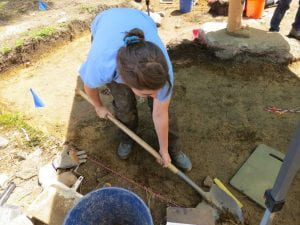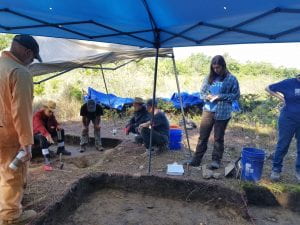On May 29th, Hassanamesit Woods Field School students returned to Grafton, Massachusetts to continue work at the Deb Newman site. Last year’s 2018 field school unearthed the remains of an eighteenth-century Nipmuc wetu, but due to time constraints they were unable to fully finish excavating the area. This year’s field school students will spend three weeks working at the Deb Newman site, and then travel to Shelter Island, New York to excavate at Sylvester Manor – a 17th century provisioning plantation that was an arena of interaction between its English owners, the Sylvesters, the enslaved Africans who lived and worked there, and the local indigenous populations who may have either traded with or worked for the Sylvesters as well.
Led by Dr. Stephen Mrozowski, Dr. Heather Trigg, and teaching assistant Gary Ellis, the field school students spent the first week in the field uncovering last year’s excavation units to finish photographing, drawing plan views and wall profiles of several units, and excavating features that were not finished last season. Features are an important component to archaeological sites, especially at this 2019 field school which is focused on unearthing a wetu. At Hassanamesit Woods, we typically find features such as post holes, hearths, stone walls, and other amorphous soil stains. These components are able to reveal more about the architecture and general use of the area by the Nipmuc.
During the second week of the field school, students broke ground on five new units while also continuing to work in last year’s units. With the new units, we are hoping to find features that can provide insight into the layout of the wetu and how the Nipmuc were utilizing the space to better understand their lives. While excavating, the field school students need to be particularly careful. Because features are such an integral component of the Deb Newman site, everyone must watch for any subtle sign of change in soil color and texture, which can indicate a potential feature. So far, a few possible post holes have been unearthed and more features with charcoal, ash, and burnt soil were uncovered, suggesting the area could have been used for food preparation or as a heat source.
Among the various types of cultural material uncovered including pearlware, creamware, glazed redware, and iron nails, some of the particularly unique artifacts found thus far include two fragments of flat window glass with tooled edges. The tooled edges indicate that the Nipmuc were modifying consumer goods in order to use it as a tool. In this case, perhaps the worked glass was used as a scraper for woodworking or on animal hides.
Archaeology is a highly collaborative discipline, and field school students experienced firsthand the ways that Fiske Center staff often lend their specialized skills to ongoing projects. For instance, this past week Dr. Trigg collected soil samples to examine phytoliths, or microscopic plant matter that usually survives well in the ground. In doing so, Dr. Trigg hopes to determine which organic materials were used by the Nipmuc when building the wetu. Dennis Piechota, the archaeological conservator of the Fiske Center, also joined the crew for a day in the field. He painstakingly carved out blocks of soil from features to take back to his lab, where the micro-stratigraphy of the samples can be analyzed to better understand the features, and by extension the people who created them.
As the field school enters its final week at Hassanamesit Woods, students and faculty are excited to continue unearthing the past to see what other features and artifacts will be revealed, so that we can learn more about the long history of the Nipmuc in Grafton.


